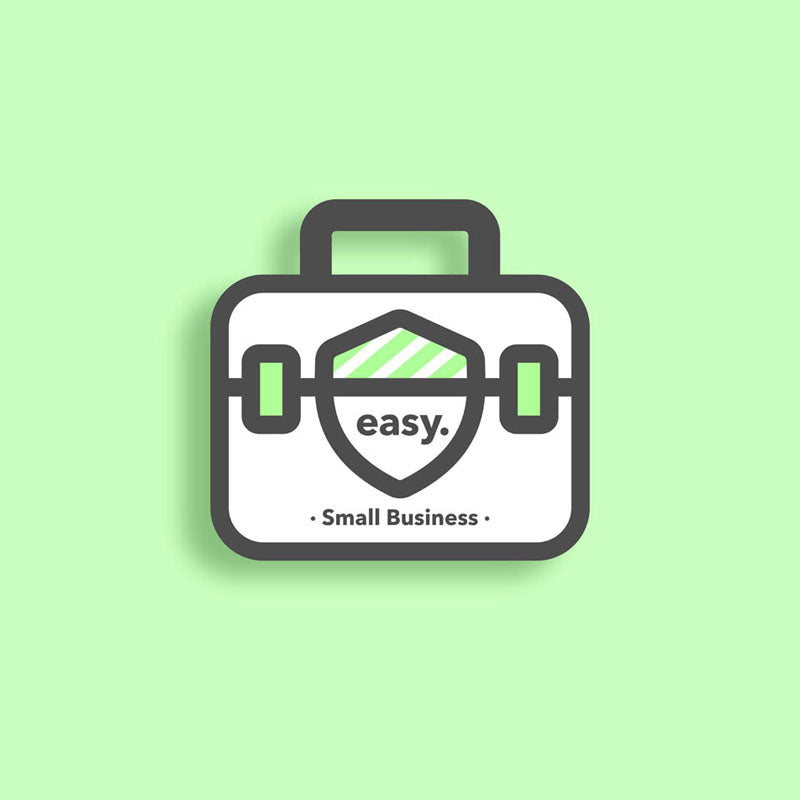
Small Business Health and Safety Templates & Guidance
Pre-filled, editable health and safety templates designed fro small businesses — including risk assessments, policies, fire safety templates, COSHH documents, and more to keep your business safe, professional, and compliant.

Keep your small business safe and compliant with our easy-to-use Health and Safety templates
Simplify health and safety management across your small business with our professionally designed templates, tailored for sole traders, start-ups, and growing enterprises. Whether you work independently, manage a small team, or run a larger operation, our editable templates help you stay compliant with Health and Safety Executive (HSE) regulations while protecting staff, customers, and contractors from everyday workplace risks.
Each document is easy to edit and many come pre-filled with detailed, small business–specific content — including risk assessments, health and safety policies, fire safety forms, COSHH documents, accident report templates, staff safety guidance, and more. This makes compliance quick, accurate, and stress-free. With our ready-to-use tools, you can focus on running your business efficiently, supporting your team, and maintaining the highest standards of health and safety compliance.

Navigating Health and Safety: Essential Insights for Small Businesses
Running a small business is an exercise in balancing multiple responsibilities, and perhaps none is more important than the health and safety of employees and customers. While the landscape of health and safety regulations can be complex, ensuring a safe workplace is not only a legal necessity but also crucial for the long-term success of your business.
The Importance of Health and Safety
Maintaining a safe and healthy work environment is not just a moral duty—it’s a legal requirement. Laws and regulations mandate compliance, and failure to adhere to them can result in severe penalties, including fines and, in the worst cases, imprisonment.
Beyond the legal implications, good health and safety practices can also have a positive impact on employee morale and productivity, reduce absenteeism, and even lower insurance premiums.
Common Areas of Concern
Risk Assessments
One of the first steps in establishing a safe workplace is identifying potential hazards. Conducting the correct risk assessments regularly can help you understand the various risks within your work environment and take appropriate action.
Fire Safety
Every business should have fire safety measures in place, such as fire extinguishers, fire alarms, and clearly marked emergency exits. Conducting a fire risk assessment is a positive step that you can take to ensure you have covered all avenues and assessed what is needed for your business premises. Regular fire drills are also important to ensure everyone knows what to do in case of an emergency.
Manual Handling
In industries requiring regular physical labour, proper manual handling techniques must be taught to employees to reduce the risk of injury. This is also important for roles in which physical labour, such as moving stock or equipment, may be necessary from time to time.
Chemical Safety (COSHH)
If your business involves the use of chemicals e.g. bleach, detergents etc, you're obligated to identify risks and establish safety measures. This can be done using a COSHH (Control of Substances Hazardous to Health) assessment.
Making Health and Safety Part of Company Culture
It's crucial that health and safety measures aren't just viewed as a potentially expensive box-ticking exercise but are integrated into your company culture. Providing ongoing training, appointing a health and safety lead (this can be any responsible person with knowledge of the business), and encouraging open communication about health and safety concerns can go a long way in maintaining a safe workplace.
In Summary...
The task of navigating health and safety laws and regulations may seem daunting, but it's an integral aspect of running a successful small business. Taking proactive steps to identify risks and establish safety measures can protect you legally and provide a better environment for your employees and customers alike.
Remember, crafting a safe business is a proactive step towards a successful business. Ignoring this vital aspect could have serious legal and financial consequences. So, make health and safety a priority, and your business will be better for it.
Top 3 Health and Safety Hazards Every Small Business Should Know
-

Slips and Trips
View ProductsSlips and trips represent a serious hazard for small businesses, with wet floors, uneven surfaces, and clutter leading to injuries that may result in legal and financial consequences. Such accidents can harm both individuals and the business's reputation, making clean, orderly, and safe premises essential for risk management and safety compliance.
-

Cleanliness & Hygiene
View ProductsCleanliness and hygiene are crucial for small businesses to maintain health standards, prevent illness, and ensure compliance with regulations. These practices are key to building customer trust and a professional reputation, especially in industries where hygiene is directly linked to customer safety, such as food service and personal care.
-

Fire Safety
View ProductsFire safety is critical for small businesses to protect lives, prevent property damage, and avoid legal and financial repercussions. Adequate fire prevention and response measures, such as detectors, extinguishers, and evacuation plans, are essential to ensure a secure environment and the business's continuity in the event of a fire.

Why pay expensive consultant fees when you can manage health and safety yourself?
Improve your compliance while saving time and money by creating health and safety documents, customised to your business, yourself. Our health and safety range for small businesses and sole traders covers a suite of essential templates including health and safety policies, risk assessments, COSHH forms, fire safety templates, health and safety guidance, safety posters and more.
Benefits of managing health and safety yourself...
-

Improve safety
Health and safety at work is about preventing accidents, incidents and ill-health by assessing the work environment, the activities within it, and taking appropriate action.
-

Ensure compliance
Our ready to use templates, many of which are pre-filled, will enable you to quickly increase your compliance to health and safety law.
-

Save money
With health and safety consultants often charging upwards of £400 per day, there is a better way. Take control and save yourself time and money.

Affordable Health & Safety Compliance for Small Businesses
Running a small business — whether you’re a sole trader, start-up, or growing enterprise — means juggling countless responsibilities at once. From managing finances and serving customers to supporting staff and keeping operations on track, it’s easy for health and safety compliance to slip further down the list than it should.
For many small business owners, finding the time and money to stay compliant with Health and Safety Executive (HSE) regulations can feel overwhelming. The focus is often on keeping the business running smoothly, but overlooking compliance can lead to unnecessary risks, costly fines, and potential harm to staff or customers.
At easyhealthandsafety, we take the pressure off by providing ready-to-use, affordable templates and step-by-step guidance specifically designed for small businesses and sole traders. Our pre-filled risk assessments, health and safety policies, fire safety forms, COSHH documents, and staff safety guidance help you stay compliant, protect your team, and safeguard your business — all without breaking the budget.
Frequently Asked Questions
Small Business Health and Safety FAQs
How can I create a risk assessment for my small business?
The easiest way to create a risk assessment is to start with a pre-filled template designed for small businesses.
Using a professionally prepared, editable template — such as our Small Business Risk Assessment Template — helps you save valuable time while ensuring compliance with Health and Safety Executive (HSE) standards. Each template is pre-filled with common workplace hazards, suggested control measures, and clear instructions tailored for small business environments. You can then customise it to match your specific activities, equipment, and staff.
If you prefer to create one from scratch, follow the five key HSE steps: identify hazards, decide who might be harmed and how, evaluate and control the risks, record your findings, and review regularly. Our risk assessment template makes this process simpler, ensuring you meet legal requirements without the stress or cost of starting from zero.
For a complete compliance solution, our Small Business Health and Safety Template Bundle includes the full Risk Assessment Template alongside over 60 essential documents — from health and safety policies and fire safety templates to COSHH forms and accident report templates. It’s the perfect all-in-one package for small business owners and sole traders who want to save time, reduce costs, and stay fully compliant with health and safety laws.
Do small businesses need to complete a risk assessment?
Yes — every small business must complete a risk assessment under health and safety law to identify and manage workplace hazards.
All employers, including small businesses and sole traders, are legally required under the Management of Health and Safety at Work Regulations 1999 to carry out a risk assessment. This helps identify potential hazards, assess who might be harmed, and put appropriate controls in place. Even if you have fewer than five employees and don’t need to record it in writing, it’s still a strongly recommended best practice measure to complete and document your risk assessment. This is because risk assessments help you identify potential hazards before they cause accidents or ill health, allowing you to take preventive action, reduce liability, and demonstrate compliance if inspected by the Health and Safety Executive (HSE) or local authorities.
Our Small Business Risk Assessment Template is editable and pre-filled with relevant content making the process of conducting your risk assessment quick, accurate, and compliant with health and safety laws and regulations.
Do small businesses need a written Health and Safety Policy?
If you employ five or more people, you must have a written Health and Safety Policy under health and safety law. Even if you have fewer than five employees, it’s still a strongly recommended best practice measure to have a written policy in place to demonstrate your commitment to safety and communicate responsibilities clearly.
Your policy should explain how you manage health and safety, who is responsible, and how you will monitor and review standards. Our editable Health and Safety Policy Template is easily tailored for small businesses. The single page format is easy to customise, helping you meet HSE expectations with minimal effort.
What are my legal responsibilities as a small business owner under health and safety law?
You are legally responsible for protecting the health, safety, and welfare of your employees, contractors, and anyone affected by your work.
Under the Health and Safety at Work etc. Act 1974, small business owners must ensure safe working conditions, provide adequate training, maintain equipment, and assess risks. You must also have suitable procedures for first aid, fire safety, and emergency planning. Even if your team is small, following these requirements is both a legal obligation and best practice.
Our Small Business Health and Safety Template Bundle includes over 60 essential documents — from risk assessments and policies to fire safety and COSHH documents — to help you meet your health and safety responsibilities efficiently.
How can I manage fire safety in my small business?
Every small business with premises must carry out a Fire Risk Assessment and maintain suitable fire safety measures.
Fire safety is a legal requirement under the Regulatory Reform (Fire Safety) Order 2005, which applies to all small businesses that own, rent, or operate from physical premises — including offices, shops, workshops, and shared spaces. You must identify fire hazards, maintain alarms and extinguishers, ensure clear escape routes, and provide fire safety training for staff. Even smaller sites with limited space or a few employees should treat fire safety as a priority and best practice.
Our Fire Risk Assessment and Essential Fire Safety Template Bundle includes fire checklists, logbooks, and evacuation planning tools to help you meet fire safety regulations confidently and efficiently.
What is COSHH, and does it apply to small businesses?
Yes — COSHH applies to all businesses that use hazardous substances, including cleaning products and chemicals.
The Control of Substances Hazardous to Health Regulations 2002 (COSHH) requires all employers, regardless of size, to assess and control exposure to hazardous substances such as chemicals, dust, fumes, or biological agents. Even basic cleaning products can pose health risks if not managed properly. Completing a COSHH assessment is best practice for all small businesses.
Our COSHH Risk Assessment Collection and Small Business Health and Safety Template Bundle include pre-filled COSHH assessments and clear guidance to help you manage chemical safety effectively and stay compliant.
What health and safety records should a small business keep?
You should keep records of risk assessments, accident reports, training, and equipment checks as evidence of compliance.
Accurate record-keeping shows that you’re fulfilling your duties under health and safety law. Even if you have fewer than five employees, it’s best practice to keep written records of your safety measures, staff inductions, inspections, and any incidents. Doing so helps protect your business during HSE inspections or insurance claims.
Our Accident Report Form and Small Business Health and Safety Template Bundle include all the key documents to help you stay organised and compliant.
How often should I review my health and safety documents?
You should review your health and safety documents at least once a year or whenever there are significant changes.
Regular reviews ensure your safety measures stay current with your operations, staff, and legislation. If your business introduces new equipment, processes, or staff, you must review your documentation immediately. Even for small teams, it’s best practice to refresh your policies and risk assessments annually.
For an all-in-one compliance solution, our Small Business Health and Safety Template Bundle includes over 60 essential documents — from risk assessments, health and safety policies and fire safety templates to COSHH forms and accident report templates. It’s the perfect all-in-one package for small business owners and sole traders who want to save time, reduce costs, and stay fully compliant with health and safety laws.
What happens if my small business doesn’t comply with health and safety regulations?
Non-compliance can result in fines, legal action, reputational damage, and even imprisonment in serious cases.
The Health and Safety Executive (HSE) has the authority to inspect any business, regardless of size. Failing to meet your legal duties under the Health and Safety at Work etc. Act 1974 can lead to enforcement notices, costly penalties, and even prosecution. Beyond the legal risk, poor safety management can cause accidents, staff injuries, and lost productivity.
Our Small Business Health and Safety Template Bundle provides all the essential tools to help you maintain compliance and avoid unnecessary risk.
How can I make health and safety management easier for my small business?
Use ready-made health and safety templates tailored to small businesses to save time and ensure compliance.
Health and safety can feel daunting for small business owners with limited time or budgets. The simplest and most efficient approach is to use professionally prepared templates that cover all legal requirements — from risk assessments and COSHH forms to fire safety and policies.
Our Small Business Health and Safety Template Bundle includes the these essential documents — and more, designed to simplify compliance, reduce admin, and give you confidence that your business meets health and safety standards without the high cost of a consultant.







